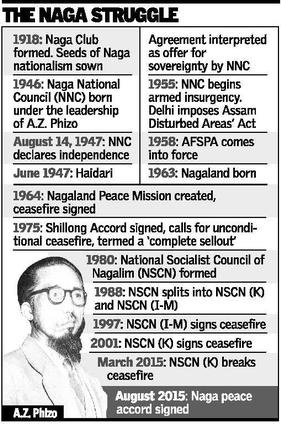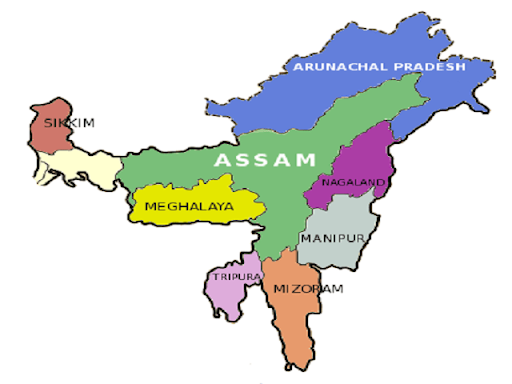Internal Security
Ceasefire With NSCN(K) Niki Group
- 09 Sep 2021
- 6 min read
Why in News
Recently, the Union Government has entered into a Ceasefire Agreement with the National Socialist Council of Nagaland (K) Niki Group for a period of one year.
- This initiative is a significant boost to the Naga peace process and in line with Prime Minister of India's vision of 'insurgency free, prosperous North East'.
Key Points
- Naga Peace Process:
- After India became independent in 1947, the Naga territory initially remained a part of Assam.
- In 1957, after an agreement was reached between Naga leaders and the Indian government, the Naga Hills region of Assam and the Tuensang frontier division to the northeast were brought together under a single unit directly administered by the Indian government.
- Nagaland achieved statehood in 1963, however, rebel activity continued.
- Vision of Insurgency Free, Prosperous North East:
- Recognises that the North East is very important for the country from the aspects of security.
- Thus, the aim is to end all disputes in the Northeast by 2022 and usher in a new era of peace and development in the Northeast in 2023.
- Under this, the Government is enriching the dignity, culture, language, literature and music of the Northeast.
- Over the years, the government has also signed several peace agreements with military outfits in northeast India. For example,
- Karbi Anglong Agreement, 2021: It involved a tripartite agreement signed among five insurgent groups of Assam, the Centre and the state government of Assam.
- Bru Accord, 2020: Under the Bru accord, the permanent settlement of 6959 Bru families in Tripura with a financial package has been agreed between the Government of India, Tripura and Mizoram with representatives of Bru migrants.
- Bodo Peace Accord, 2020: In 2020, the Government of India, Government of Assam and representatives of Bodo groups signed an agreement, wherein more autonomy is provided to Bodoland Territorial Region (BTR), in Assam.
- Peace agreement with various military outfits which are involved in Naga Insurgency like NSCN(NK), NSCN(R), and NSCN(K)-Khango, NSCN(IM).
Conflicts in Northeast India
- Typology of Conflicts:
- National Conflicts: Involving the concept of a distinct ‘homeland’ as a separate nation.
- Nagaland: Naga insurgency originated from the demand of independence.
- Although the demand for independence has majorly subsided, the lingering issue of a final political settlement including the demand for ‘greater Nagaland’ or ‘Nagalim’ remains.
- Nagaland: Naga insurgency originated from the demand of independence.
- Ethnic Conflicts: Involving assertion of numerically smaller and less dominant tribal groups against the political and cultural hold of the dominant tribal group.
- Tripura: The State’s demographic profile has been altered since 1947 when mass migrations from the newly emerged East Pakistan converted it from a largely tribal area to one with a majority of Bengali speaking people.
- Tribals were deprived of their agricultural lands at throw-away prices and driven to the forests.
- The resultant tensions caused major violence and widespread terror.
- Tripura: The State’s demographic profile has been altered since 1947 when mass migrations from the newly emerged East Pakistan converted it from a largely tribal area to one with a majority of Bengali speaking people.
- Sub-regional Conflicts: Involving movements which ask for recognition of sub-regional aspirations and often come in direct conflict with the State Governments or even the autonomous Councils.
- Mizoram: The State with its history of violent insurgency and its subsequent return to peace is an example to all other violence affected States.
- Following an ‘Mizo Peace accord’ between the Union Government and the Mizo National Front in 1986 and conferment of statehood the next year, complete peace and harmony prevails in Mizoram.
- Further, the boundary issue between Assam and Mizoram has existed since the formation of Mizoram.
- Mizoram: The State with its history of violent insurgency and its subsequent return to peace is an example to all other violence affected States.
- Other Reasons: Sponsored terrorism, conflicts generated as a result of continuous inflow of migrants from across the borders, criminal enterprise aimed at expanding and consolidating control over critical economic resources, have also result into clashes.
- Assam: The major ethnic conflict in the State is the grievance against the perceived influx of ‘foreigners’ i.e. people with a language and culture substantially different from the Assamese from across the border (i.e. Bangladesh).
- The recent tension in Assam emanates from the Citizenship (Amendment) Act, 2019 and National Register of Citizens debate.
- Assam: The major ethnic conflict in the State is the grievance against the perceived influx of ‘foreigners’ i.e. people with a language and culture substantially different from the Assamese from across the border (i.e. Bangladesh).
- National Conflicts: Involving the concept of a distinct ‘homeland’ as a separate nation.
- Modes of Conflict Resolution:
- Strengthening security forces/ ‘police action’.
- More local autonomy through mechanisms such as conferment of Statehood, the Sixth Schedule, Special Provisions under PART XXI of the Constitution.
- Negotiations with insurgent outfits.
- Development activities including special economic packages.






